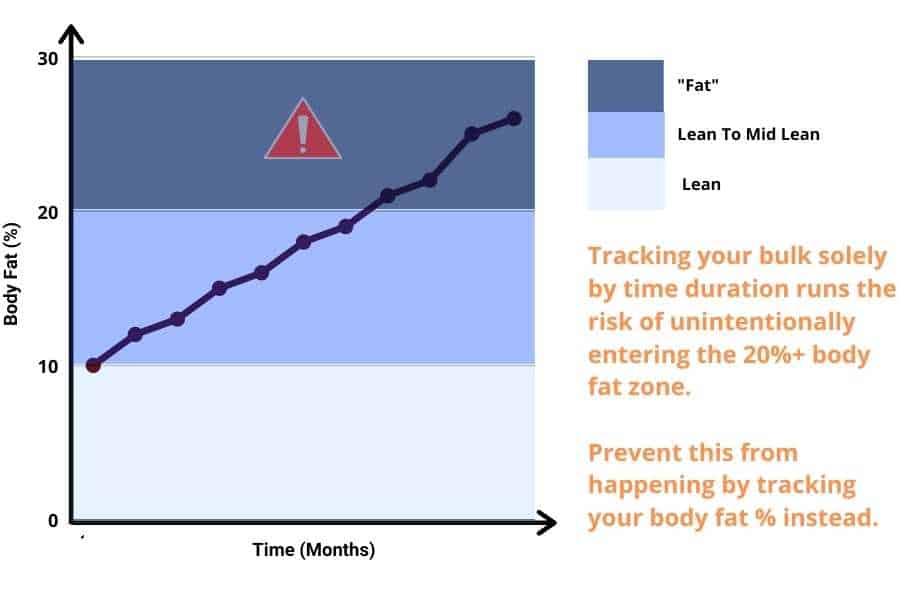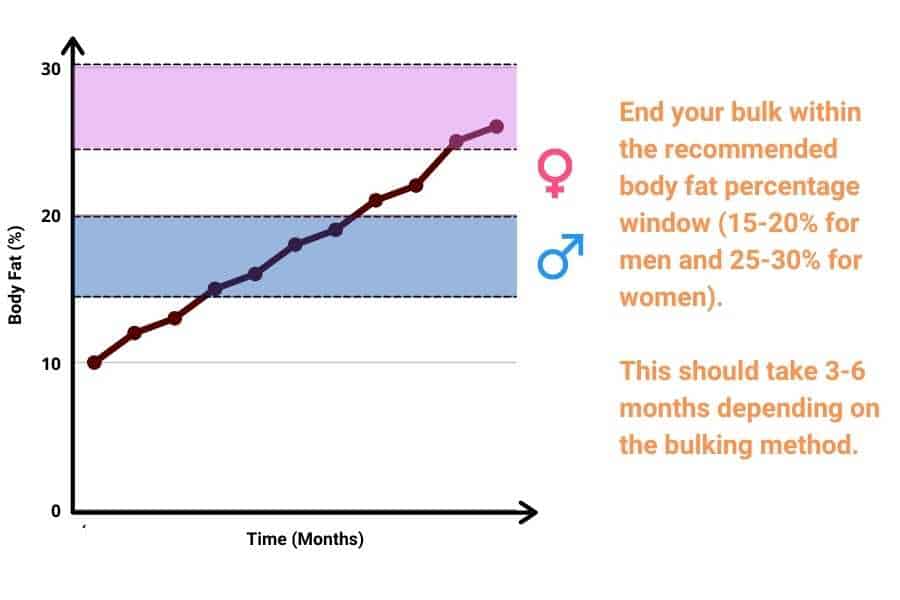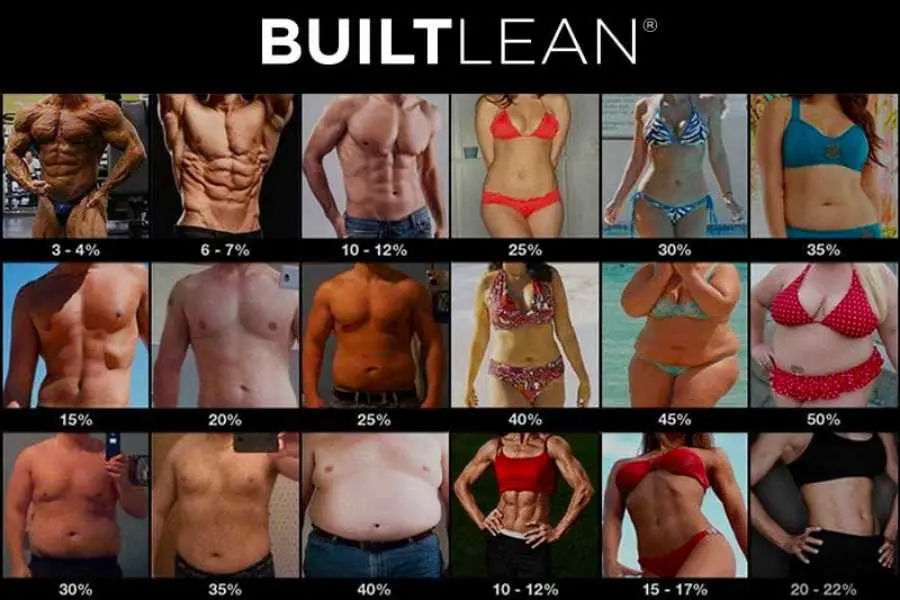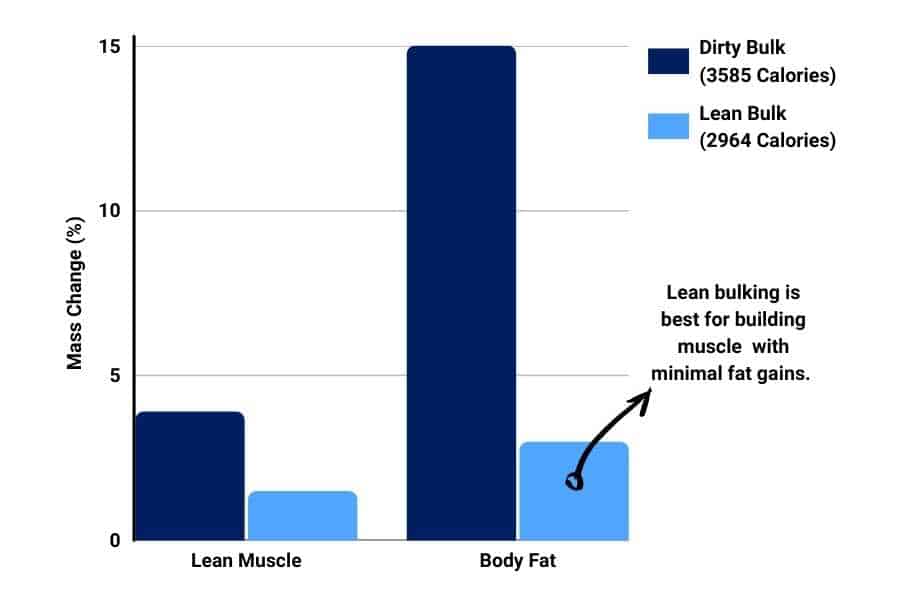Choosing the correct duration for a bulking cycle is essential if you want to gain high-quality lean muscle mass. If your cycle is too long, you risk gaining excessive body fat. But if your cycle is too short, you may not build as much muscle as you would have liked. So how long should you bulk for as a beginner?
Beginners should aim for a 3-6 month bulk. The ideal duration depends on the strategy adopted, long-term goals, and current body fat percentage (skinny people can usually bulk for the longest). Additionally, bulking should end when body fat reaches 15-20%.
The last thing you want to do is make the same newbie mistake I made- mindlessly following a pre-determined timeline without regard for the amount of fat being gained. This resulted in a “chunky” physique that doesn’t look ripped…at all.

- Key Takeaways
- Ideal Bulking Duration For Beginners
- Why Beginners Should Be Flexible With Bulking Duration
- When To Stop A Bulk
- Ideal Rate Of Weight Gain During A Bulk
- Bulking Crashcourse For Newbies
- How Beginners Should Train Whilst Bulking To Build Muscle
- Is It Difficult For A Beginner To Bulk?
- When To Start Cutting
- Conclusion
Key Takeaways
- The general recommendation is 3-6 months (enough time for most beginners to build muscle).
- But the ideal duration depends on the type of bulk, long-term goals, and current body fat percentage.
- A good rule of thumb is to stop bulking when you exceed a 15-20% body fat threshold (regardless of your initial proposed timeline).
- The lean bulking method generally lasts longer than the dirty method and results in a lean-muscular physique when done properly.
- Dirty bulks are generally shorter and usually result in a fat-muscular physique.
Ideal Bulking Duration For Beginners

Beginners should aim for a 3-6 month cycle. However, these recommendations are highly generalized. Some people may want to go on a longer cycle whilst others may want to keep it short.
Recommended bulking durations according to personal goals and current body fat percentage:
| Dirty Bulk | Lean Bulk | |
|---|---|---|
| Recommended Duration: | 3 months | 3-6 months |
| Expected results: | Chunky-muscular physique | Lean-muscular physique |
| Ideal for: | People who are very skinny | Skinny or skinny-fat people |
Factors that come into play when deciding how long a bulk cycle should last:
- Bulk method. The dirty method is ideal for the fastest muscle gains but also results in a faster rate of fat gain. In contrast, the lean method has a moderate rate of muscle gain but also a much slower rate of fat gain. The latter method can be sustained for longer compared to the former.
- Long-term goals. Choose a longer cycle if your aim is to gain as much body weight as possible, leading to a fat-muscular look (think of a strongman). Choose a shorter cycle if your aim is to build a lean ripped-muscular physique (think of a fitness model).
- Current body fat percentage. Skinnier people can stay in a caloric surplus for longer compared to people with higher body fat levels.
Why Beginners Should Be Flexible With Bulking Duration
Bulking is a skill that takes time to master. And if this is your first time, then there’s a good chance that your calorie intake and training may not be 100% optimal. This is normal for a beginner.
Therefore you should know when to stop a bulk, regardless of your initial proposed timeframe.
Consider the two examples below:
- Person A (newbie). This is a beginner who’s looking to lean bulk for 6 months. But they are following a sub-optimal training program and overeating the recommended calories for a lean bulk (turning it into a dirty bulk). As a result, they are gaining lots of excess fat and relatively little muscle mass. It would be disastrous for this person to keep bulking for 6 months. It would make more sense to stop the cycle when the body fat percentage becomes too high and go on a cut before resuming the bulk.
- Person B (more experience). This is also a beginner, but with a bit more experience. They are also aiming to lean bulk for 6 months. They are following an optimized training program and sticking to their recommended calorie intake for a lean bulk. As a result, they are gaining muscle at a steady rate with minimal fat gains. This person could stay bulking for much longer than person A.
Take-home message:
It’s difficult to get a bulk 100% right as a first-time beginner. Know when to stop to avoid gaining too much excess body fat (see next).
When To Stop A Bulk
Tracking your body fat % is the best best way to decide when to end your bulk (as opposed to mindlessly sticking to a pre-determined timeline). This prevents the over-storage of excess fat which most people generally like to avoid.

So how much body fat % should you reach before you end your bulk?
Studies indicate that a healthy body fat percentage is around 15% for males and 25% for females. Therefore, men should stop bulking at 15-20% body fat, and women at 25-30% body fat.
This is the healthiest way to gain weight.

Additionally, maintaining muscle tone and definition is something that most people strive for. By sticking to the body fat percentage windows recommended above, you can maintain visibly defined muscles whilst bulking. Exceeding the body fat percentage window leads to muscle definition being hidden by excess fat.

You can use charts like this one from Built Lean to determine your body fat percentage.
Ideal Rate Of Weight Gain During A Bulk
Beginners should aim to increase body weight by 0.25-0.50% per week during a bulk. This equates to approximately 0.25-1.00lbs per week or 1-4lbs per month, depending on current body weight.
Speaking from personal experience, it’s even ok to put on weight at up to 2lbs per week if you are someone who is very skinny and doesn’t mind gaining some fat along with muscle.
But generally speaking, most people should aim to limit weight gain to 0.25 to 1.00lbs per week, as recommended by this 2019 review. Avoid putting on more than 2lbs per week.
Healthy rates of weight gain at different body weights:
| Current Body Weight (lbs) | Weekly 0.25% Weight Gain (lbs) | Weekly 0.50% Weight Gain (lbs) |
|---|---|---|
| 100lbs | 0.25lbs | 0.50lbs |
| 110lbs | 0.28lbs | 0.55lbs |
| 120lbs | 0.30lbs | 0.60lbs |
| 130lbs | 0.33lbs | 0.65lbs |
| 140lbs | 0.35lbs | 0.70lbs |
| 150lbs | 0.38lbs | 0.75lbs |
| 160lbs | 0.40lbs | 0.80lbs |
| 170lbs | 0.43lbs | 0.85lbs |
| 180lbs | 0.45lbs | 0.90lbs |
| 190lbs | 0.48lbs | 0.95lbs |
| 200lbs | 0.50lbs | 1.00lbs |
| 210lbs | 0.53lbs | 1.05lbs |
| 220lbs | 0.55lbs | 1.10lbs |
Take-home message:
Aim to increase your body weight by 0.25%-0.5% per week until you have reached 15-20% (men) or 25-30% (women) body fat. At this point, you can end your bulk and begin your cut. This ensures lean muscle gains with minimal fat storage.
For more information (and photos from my own weight-gain journey), you can go to my other post to find out how long it usually takes a skinny person to gain weight.
Bulking Crashcourse For Newbies
There are 2 main requirements for a bulking up:
- Eating more than your daily maintenance calories to gain weight. This is also called going on a “caloric surplus”.
- High protein intake to build muscle. 1g per lb of body weight is generally recommended.
Consuming enough carbs and fats is also recommended. But calories and protein are the most important.
Here’s an outline of what a typical bulking diet looks like:
| Macronutrient | Approximate Grams Per Day | Reason | Examples |
|---|---|---|---|
| Protein | 1g per pound of body weight | Protein is required to build muscle. If you under-consume protein, your body will not build muscle. | Lean red meat, poultry, fresh fish and shellfish, legumes, and soy products. |
| Complex Carbohydrates | 2.5g per pound of body weight | Complex carbs fuel your workouts. Aim to consume most of your carbs during the day (especially pre and post-workouts). | Potatoes, whole grain pasta/bread, legumes. |
| Healthy Fats | 0.4g per pound of body weight | Healthy fats also fuel your workouts. But they are also required for hormone production and muscle growth. | Oily fish, nuts, seeds, vegetable oils, avocados. |
Furthermore- there are two types of bulk, each differing in calorie surplus:
- Lean- typically a 5-10% surplus and undertaken for 3-6 months.
- Dirty- typically a 15-20% surplus and undertaken for ~3 months max.
So which method should you opt for as a beginner?
I advise trying a lean bulk first. It’s not easy for a newbie to go on a calorie surplus. And the lean method requires you to eat less food than the dirty method, whilst also allowing you to build muscle (when combined with heavy weight training).

Additionally, this 2013 study suggests dirty bulking provides relatively little extra muscle gains compared to lean bulking. Furthermore, the former method results in much more fat gains.
With that being said, beginners who are very skinny could consider the dirty method to rapidly gain overall body weight (including fat and muscle).
How Beginners Should Train Whilst Bulking To Build Muscle
Optimizing your workout routine will help you to maximize muscle and minimize fat gains.
Training tips for beginners to build muscle on a bulk:
- Lift heavy weights. Anything over 70% of your 1RM can promote muscle growth.
- Keep workouts short and intense. A good workout shouldn’t last more than 1 hour for maximum hypertrophy (muscle-building) benefits.
- Do not overtrain. You do not have to work out every day to gain muscle. 3 high-quality workouts per week with sufficient rest in between is ideal for beginners.
- Aim to complete a sufficient training volume. Each major muscle group should get 10-15 total sets per week. Work in the 8-12 rep range. And lift a weight that challenges you for the allotted reps.
- Prioritize the big lifts. Examples include bench presses, shoulder presses, rows, squats, and deadlifting. These movements help ensure that the calories from your bulk go towards muscle gain rather than fat storage.
Is It Difficult For A Beginner To Bulk?
Bulking can be difficult without advanced planning.
You should first identify your daily target calories and protein. Then plan your meals to reach those targets.
Beginners commonly struggle with eating a calorie surplus. I recommend spreading your calories over multiple meals per day to reduce the uncomfortable bloated feeling.
Limiting your bulk to around 3 months can also make things easier for beginners.
For more tips, you can check out my guide on bulking up at home.
When To Start Cutting
People typically start a cutting season after a bulking season. A bulk usually lasts for 3-6 months or until body fat reaches 15-20% for men and 25-30% for women.
Bear in mind- you don’t have to cut if you don’t want to.
If you’re someone who is very skinny, then you may prefer the extra body weight that results from a successful bulk. In this case, you can work on maintaining that weight by eating maintenance calories.
But if you’re looking to lose excess fat and get ripped or shredded, then you will need to cut. Furthermore, most people usually go on multiple bulk-cut cycles to reach their target physique.
Conclusion
Beginners should aim to lean bulk for 3-6 months gaining weight at approximately 0.25lbs to 1.00lbs per week. Done properly, this will help you develop a ripped and muscular body.
People who are very skinny may choose to dirty bulk for around 3 months. This results in a slightly faster rate of muscle gain, but also much faster fat storage.
Regardless of the strategy chosen, you should stop a bulk once you’ve reached 15-20% body fat (men) or 25-30% (women).
You may also be interested in the downloadable Kalibre Blueprint PDF which details exactly how I gained 40lbs of lean muscle (it’s 100% free!). It details the exact exercises and nutrition (with printables) I used to go from skinny to ripped!


